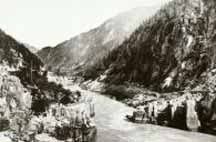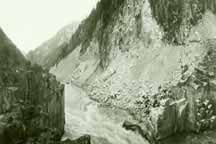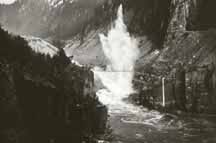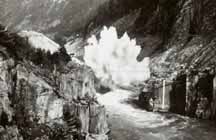Only 77 years after Simon Fraser reached the Pacific Coast, the first railway, the Canadian Pacific Railway, was built from east to west, down the Fraser to the Pacific and completed in 1885. Most of the railway construction through the Fraser Canyon was accomplished by blasting and excavation of rock, mostly dumped into the river or onto riverbanks. It was known even then that salmon had difficulties passing upstream through the canyon, particularly at Hell's Gate, about halfway in the rocky gorge. However, no major threat to the survival of the fishery was felt. At the time there were numerous canneries on the coast of British Columbia and Washington State, with millions of salmon caught each year off-shore and in the river.
The problem for the salmon in the Fraser River system became very serious when a second railway was constructed on the East Bank of the Fraser River Canyon during the years 1912-14. This railway, named Great Northern Railway, later re-named the Canadian National Railway (CNR) had only the second choice of locations along the river banks, requiring more blasting and rock removal, most of which was dumped rather indiscriminately into the river at many points. The rock discarded in the river created flow conditions that were almost impassible for salmon migrating upstream in the summer and fall of 1913. Only the stronger salmon were able to migrate up through the canyon and beyond to their spawning streams. At the time, some efforts were made to remove part of the rock waste from the river, however, with little success. It was very apparent that the multi-million salmon runs up the Fraser River were seriously jeopardized.
The final devastation to the Fraser River salmon occurred on February 23, 1914, when a huge rock cliff above a newly blasted (CNR) railway tunnel collapsed into the river at Hell’s Gate. More than 100,000 cu. yards of rocks as big as houses filled every embayment and projected on to the bed of the river. The slide material narrowed the canyon at that point from about 300 feet to 75 feet and formed a cascade of water dropping more than 20 feet over a distance of less than 75 feet. With such a catastrophe, it was soon clear that the salmon runs expected to arrive the following summer would not make it upriver.







Click on images to enlarge